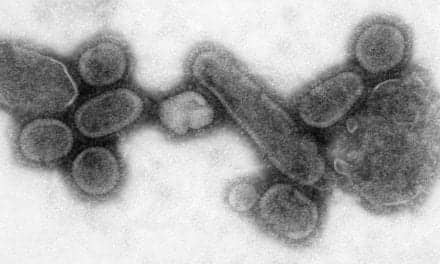A news release from Biophysical Society indicates that researchers have built a complete model of the outer envelope of influenza A virus using a combination of experimental data from NMR spectroscopy, X-ray crystallography, cryoelectron microscopy, and lipidomics.
This approach, which is known as coarse-grained molecular dynamics simulation, has enabled researchers to generate trajectories at varying temperatures and lipid compositions and revealed characteristics that may help scientists better understand how the virus survives as well as discover new ways to fight it.
The Biophysical Society news release notes that their computer simulation begins by rendering the virus as a fairly large 73-nanometer ball of loosely packed lipids, which relaxes down into a smaller, 59-nanometer virion within 300 nanoseconds. The viral spike proteins are then embedded into the lipid envelope individually before adding solvent to the system. Tyler Reddy, a postdoctoral fellow at the University of Oxford, states, “In the current publication, this is just a single virion in a water droplet — but what could really get interesting is if we start putting in other molecules of interest, such as therapeutic agents.”
Reddy and fellow researchers have found from the stimulation that the viral spike proteins protruding from the virion’s membrane spread out instead of aggregating close together. This is key to the strength of the interactions between influenza A virions and host cells, which are determined by the number of spike proteins that can engage with receptors, according to the Biophysical Society.
Reddy says, “If the separation of the spike proteins is compatible with the ‘arms’ of Y-shaped, bivalent antibodies, this information might be exploited in therapeutic design, so that two antigens may be bound simultaneously for enhanced association.”
The researchers observed that the Forssman glycolipid had a role in preventing protein aggregation and slowing down protein diffusion. In addition, Reddy’s simulation presently monitors the virion’s stability on the microsecond scale, though the Biophysical Society news release notes it will be a challenge to assess stability over much longer time scales.
Reddy declares, “We are a long way from being able to perform molecular dynamics simulations that span the year time scale. Nonetheless, we now have a platform for looking at influenza A virion behavior in silico, and perhaps certain compounds or solutions could be used to accelerate destabilization on an observable time scale.” He adds, “We’re making the coordinate data freely available in the hopes that other groups have interesting ideas for use with this model as well, and so that they can criticize and help improve the model.”
Source: Biophysical Society










